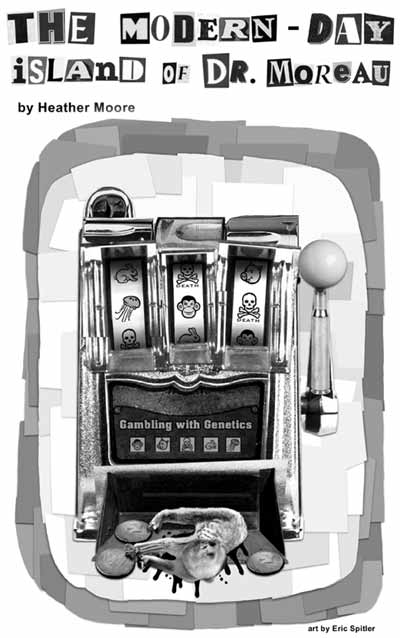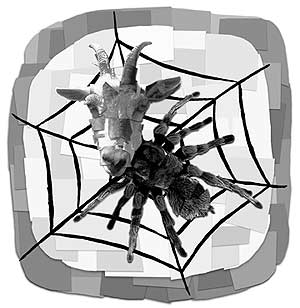

The Island of Dr. Moreau Revisited

E-Mail Us
Your Comments
|

In 1996, the movie version of H.G. Wells' science-fiction classic The Island of Dr. Moreau, an eerie tale about a deranged scientist who performs gene-splicing research on animals in order to create a superior race of humans,
was updated to incorporate more recent developments in genetic engineering. Wells' prophetic nightmare is edging closer to reality each day as scientists find new and bizarre ways to manipulate animals.
Virtually every species of domesticated animal has been tampered with as scientists attempt to create "new and improved" companion animals, research tools, and food sources. Non-allergenic cats, glow-in-the-dark bunnies, mutant monkeys, silk-producing goats, giant mice, "Frankenfish," Enviropigs, and other transgenic (genetically altered) animals have made international news and raised the ire of many people who feel that it is unethical for scientists to play God with animals' lives.
Transgenic "Pets"
Nevertheless, in two years, Transgenic Pets, LLC, of Syracuse, N.Y., plans to sell cats who have been genetically engineered so that they won't trigger allergies in people. David and Jackie Avner, who formed the company two years ago, claim that conventional breeding has failed to rid cats of an allergen called "Feld 1," which is secreted onto the cat's fur.
The Avners have contracted with Dr. Xiangzhong (Jerry) Yang, a biotechnologist at the University of Connecticut, to research and develop the allergy-free cat through a combination of "gene targeting" and cloning. The cat's skin cells would be altered to contain a faulty copy of the "Feld 1" gene. The altered cells would then be fused with egg cells, as in cloning. If the resulting modified cats somehow turn out healthy--which is unlikely--they will be interbred and their offspring will be sold for $750 to $1,000 each.
Of course, the Feld 1 protein may play a role in protecting cats from bacteria. Dr. Yang does not know what will happen if the protein is removed from cats. He says that they will "just have to remove it and see what happens." No previous attempts have been made to remove the allergen from cats, yet Mr. Avner claims that it will not affect the cat's health and that the cats will be "completely normal." This alteration amounts to "simply removing a non-essential biological aspect of the cats," according to Avner.
Avner chose not to mention that mortality rates for animals in transgenic research are very high--80 to 90 percent--and that animals who do survive are frequently born with severe physical abnormalities, including missing limbs, facial clefts, and massive brain defects. Genes are present in living organisms for reasons not completely understood, and tinkering with them often causes animals physiological and immune system problems that researchers can neither anticipate nor control.
Regardless of the dangers posed by gene manipulation, animal shelters already euthanize 7 to 8 million homeless cats each year. There is no justification for "creating" new cats when so many others are being destroyed. There are simple, ethical, and effective ways to cope with allergies to cats and other animals. (See PETA's Web page on transgenic cats for tips on dealing with allergies to animals.) If the Avners want a cat so badly and they cannot learn to cope with their allergies, perhaps they should work to identify and disarm those of their own genes that react to the allergen!
Designer Animals
 The Avners certainly aren't the first to attempt to alter the genetic makeup of companion animals. Several companies are currently working to clone and "improve" companion animals. Philip Damiani, director of the Companion Animal and Endangered Species Project at Advanced Cell Technology, suggests that "if your first cat died of cancer, you might make the next one resistant to that kind of tumor." Charles Long of Texas-based Genetic Savings and Clone says that his company could help destroy the genes that cause hip malformations in some large breeds of dogs.
Noble thoughts, perhaps, but aside from the aforementioned hazards of breeding and manipulating animals, these experiments open the door to even more exotic and questionable modifications to animals' personalities and appearances. Although he does not feel that there would be a huge demand for one, Long says he is "pretty sure we could make a blue dog."
Transgenic "artist" Eduardo Kac wanted to exhibit a glow-in-the-dark dog, but since that technology was not yet possible, he commissioned scientist Louis-Marie Hodebine and others at the National Institute of Agronomic Research in France to create a fluorescent green bunny, named Alba.
Alba was "born" in February 2000, as a result of a process called zygote microinjection. The experimenters extracted a fluorescent protein from a jellyfish and enhanced its glowing properties twofold. The enhanced gene was then inserted into a fertilized rabbit egg cell that eventually became Alba.
Kac had intended to take custody of Alba, but because of growing concerns for her welfare and the potentially devastating effect the bunny would have on the ecosystem if she were to escape and reproduce, she was not released to Kac.
An assistant professor of art and technology in Chicago, Kac contends that transgenic art is "important because it places genetic engineering in a social context in which the relationship between the private and the public spheres are negotiated. In other words, biotechnology, the private realm of family life, and the social domain of public opinion are discussed in relation to one another." To put it simply, he thought it would be really cool to have an animal that glows in the dark.
Helping or Hurting?
Alba is not the only phosphorescent creation worthy of a Mary Shelley novel. Jellyfish genes have been inserted into other animals for use in torturous laboratory experiments. In 1997, Tokyo experimenters added the glowing genes to mice who were used as models for studying diseases. The Children's Hospital in Columbus, Ohio, recently implanted jellyfish genes in at least 14 rhesus macaque monkey fetuses, and the Oregon Regional Primate Research Center (ORPRC) made headlines for "creating" ANDi ("inserted DNA" abbreviated backwards). ANDi is the sole survivor of 40 embryos (also inserted with jellyfish genes) that were implanted in rhesus monkeys
Why this fascination with jellyfish genes? Why not just insert the genes that cause disease and get on with the business of curing disease, which the experimenters claim is their goal? According to experts, most viruses and disease-causing genes are too large to insert into monkeys'--or our own--genes or are inactivated by ORPRC's methods, so finding cures to diseases seems highly improbable. Even Dr. Rudolph Jaenisch, creator of the first transgenic mouse, believes that "it is very unlikely from all we presently know about diseases that there will be any breakthrough with this creation of ANDi."
Perhaps even more disturbing is that the ORPRC receives funding from the well-known birth defect charity March of Dimes. Most contributors to the March of Dimes are completely unaware that their donations are given to scientists at facilities that waste precious research dollars and animals' lives by genetically engineering animals.
Genetically modified animals commonly suffer and die as scientists make futile attempts to cure human diseases using animal models. For example, Harvard University's patented "oncomouse," a mouse with an inserted human cancer gene, quickly develops fatal breast cancer. Similarly, genetically altered "cystic fibrosis mice" commonly die within 40 days.
Such terrible suffering is completely needless. Enormous variations exist among species, and meaningful scientific conclusions cannot be drawn about one species by studying another. In the case of the "cystic fibrosis mice," the animals do become ill, yet their lungs do not become infected or blocked with mucus as they do in human patients. Therefore, the findings from the study are irrelevant to humans.
Countless other animals are subjected to harmful genetic modifications for transplant purposes. Yet xenotransplants, in which the organ of one species is transplanted into another, always fail because the differences between people and animals are so great. It is simply not possible to predict or quantify the risk of xenotransplants for both animals and humans. Many people also fear that these transplants will result in the emergence of new, deadly human diseases.
Regardless, Cambridge, England-based Imutran, the world leader in xenotransplantation, has been breeding pigs with a human gene in an attempt to create animal organs that will not be easily rejected during human transplant operations. A Daily Express exposé of Imutran reported that the company caused horrible suffering when transplanting the modified pigs' hearts and kidneys into monkeys. According to witnesses, the animals were huddled together, shivering, and having spasms. Some had swellings or bruises; some had blood or pus seeping from their wounds. Others vomited or suffered from diarrhea. Many of the primates died during the operation because of "technical failures." Others died from organ failure just days later.
Researchers at another British firm, PPL Therapeutics, are equally eager to clone pigs with genetically altered organs for use in xenotransplants. PPL Therapeutics, the same firm that cloned Dolly, committed a serious ethical infringement by inserting the DNA of a Danish woman into thousands of New Zealand sheep without her knowledge or consent. The company hopes to make a profit from this action by extracting a protein, which it claims might help cure diseases such as cystic fibrosis, from the modified sheep's milk.
Nexia Biotechnologies, one of Canada's most prominent animal transgenic companies, believes it is "on the verge" of producing goats that will secrete spiders' silk in their milk. Nexia scientists expect the offspring from two male transgenic goats and a herd of unmodified females to produce milk containing the spider silk protein, which Nexia plans to use to manufacture a material lighter and stronger than steel. Nexia will supposedly use the material for aircraft, racing vehicles, bulletproof clothes, sutures, and artificial tendons, ligaments, and limbs.
However, experiments on genetically altered animals will not be any more useful or relevant than experiments on nongenetically engineered animals. All animal experiments are a cruel and dangerous waste of time, and despite the self-professed good they claim to be doing, it seems that some scientists simply have a need to control things that do not need to be controlled.
Super-Sized Animals
 Ethics aside, numerous studies have proven that people should forget about the leaner, genetically altered slab of beef and switch to plant-based diets for health reasons. Animal products are known to cause heart disease, high cholesterol, high blood pressure, strokes, obesity, cancer, diabetes, and a myriad of other health problems. They also contain dangerous antibiotics and unnatural chemicals. Yet, instead of advocating vegetarianism, some scientists are trying to create animals that produce double the normal meat yield.
After Se-Jin Lee, a professor of genetics at Johns Hopkins University in Baltimore, discovered a gene that regulates muscle growth and accidentally produced a family of giant mice, the University set up MetaMorphix, a company that would attempt to develop giant lobsters, chickens, pigs, sheep, and cattle by blocking the genes that limit the animals' natural growth.
MetaMorphix believes that it can accelerate growth rates in certain species by about 12 percent and create adult animals who are up to 50 percent larger and have a much higher proportion of muscle than nature intended.
The gene-blocking procedure is being widely used to create super-size fish, deemed "Frankenfish" by opponents of genetic manipulation. For example, Cape Aquaculture Technologies (CAT) in Massachusetts is working to create giant fish and shellfish; Rex Dunham, a researcher at Auburn University, is currently seeking federal approval to sell engineered catfish that grow 60 percent faster than normal; and Canadian-based Af Protein has created a transgenic salmon that grows far faster and larger than regular salmon.
But genetically altering animals to grow larger and more rapidly is nonsensical considering that humans are perfectly healthy, and far better off, without meat and dairy products. It's even more absurd to engineer cows to produce more milk when there is already a surplus of milk in the United States and Europe. But that hasn't stopped Monsanto, a chemical firm, from using BST (bovine somatotropin) to induce cows into producing excess milk. The hormone, commonly known as Bovine Growth Hormone or BGH, puts cows at increased risk for painful udder infections known as clinical mastitis and increases the likelihood that the milk will contain pus and dangerous antibiotics. Monsanto is simply increasing the dangers of an already-unhealthy product.
Sixteen years ago, the U.S. Department of Agriculture announced that it had created the world's first transgenic livestock animal. The result horrified the public--sickly, mutant pigs crippled by gastric ulcers, arthritis, and other illnesses. Undeterred, experimenters are continuing to fiddle with pigs until they mutate them into practically different beings. The Georgia biotech company ProLinia, Inc., has already drawn up a business plan for cloning and engineering livestock. ProLinia wants to sell pigs that will produce leaner bacon and meatier pork chops. Smithfield Foods, one of the world's largest pork producers, has already invested $1 million in ProLinia's plan.
Still other pork producers, concerned over the public backlash in response to the appalling pollution and waste-runoff from hog farms, have even attempted to create an "Enviropig," a genetically altered pig who supposedly produces more environmentally friendly manure. To create the Enviropig, biotechnologists spliced mice genes and E. coli bacteria, into pig genes. According to the biotechnologists, this will reduce the amount of phosphorus in pig waste.
Maybe, but phosphorus isn't the only pollutant produced by hog farms. And the stench and waste generated by hundreds of thousands of terrified pigs is not going to go away that easily. Besides, even if the "Enviropig" reduced the dangerous waste runoff from factory farms, the development of the animal would only result in widespread animal cruelty and human health problems.
Tainted pork, from pigs genetically engineered to develop a disorder similar to diabetic blindness in humans, was unknowingly eaten after the pigs were stolen from the University of Florida. The meat was ground up, made into sausage and served at a funeral--an appropriate place considering that pork from both altered and unaltered pigs can be deadly.
University officials do not know what effect, if any, the treated meat could have on people who eat it. The effect of eating "regular" pork, however, is widely known. Pork consumption can lead to heart attacks, strokes, high cholesterol, obesity, and high blood pressure. The cramped conditions on hog farms also foster diseases such as dysentery, cholera, trichinosis, and toxoplasmosis. The day that any pork product is "safe" will be the day that pigs fly.
Unnecessary Fuss
Unfortunately, the genetic alterations have only just begun. The aforementioned animals are just the tip of the iceberg--countless other animals are being mutated and "reinvented" behind closed laboratory doors all around the world. Truly progressive, modern scientists advocate vegetarianism and alternatives to animal-testing, but Frankenscientists simply fail to realize that people are much better off without the use of animals--whether genetically engineered or not.
And where will it all end? Will scientists next attempt to create dogs that can fix cars, monkeys that exhibit specific diseases at the push of a button, and pigs that grow chicken wings and do not make waste? At the moment, there is little to stop them. Laws regulating genetic engineering and animal welfare are minimal and filled with loopholes. It's up to the public to inform these experimenters that it's simply not nice to fool with Mother Nature.
Heather Moore is a staff writer for People for the Ethical Treatment of Animals.
•
Email your feedback on this article to editor@impactpress.com.
Make an IMPACT
|





